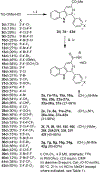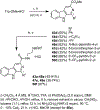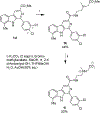β-Carboline-3-carboxamide Antimalarials: Structure-Activity Relationship, ADME-Tox Studies, and Resistance Profiling
- PMID: 39466084
- PMCID: PMC11973535
- DOI: 10.1021/acsinfecdis.4c00653
β-Carboline-3-carboxamide Antimalarials: Structure-Activity Relationship, ADME-Tox Studies, and Resistance Profiling
Abstract
The development of parasite resistance to both artemisinin derivatives and their partner drugs jeopardizes the effectiveness of the artemisinin combination therapy. Thus, the discovery of new antimalarial drugs, with new mechanisms of action, is urgently needed. We recently disclosed that β-carboline 1a was orally efficacious in Plasmodium berghei-infected mice and that it showed low cross-resistance between susceptible Plasmodium falciparum and four different drug-resistant strains. In this report, we describe the synthesis and in vitro antimalarial evaluation of 91 new derivatives of 1a. The asexual blood stage growth inhibition data show a clear preference for a 3,4-dihalogenated, 3,5-dihalogenated, 3,4,5-trichloro-, or 4-trifluoromethyphenyl ring at the C1-position. The most potent compound, 3,4,5-trichlorophenyl-substituted 42a, is twice as potent as 1a. Six potent analogues were assessed for their drug-like properties, and four of these were subjected to in vitro barcoded cross-resistance profiling. Compounds 1a, 1m, 42a, and 42m showed no cross-resistance to 32 resistance mutations on the Dd2 genetic background and 10 resistance mutations on the 3D7 genetic background. These data suggest that compounds in this scaffold possess a novel mechanism of antimalarial action.
Keywords: ADME-Tox; anti-infective; malaria; resistance profiling; small-molecule inhibitor.
Figures





References
-
- World Malaria Report 2023. The World Health Organization, available at https://www.who.int/publications/i/item/9789240086173, last accessed 6/20/24.
-
- Rosenthal PJ; Asua V; Conrad MD, Emergence, transmission dynamics and mechanisms of artemisinin partial resistance in malaria parasites in Africa. Nat. Rev. Microbiol 2024, 22 (6), 373–384. - PubMed
-
- Tumwebaze PK; Conrad MD; Okitwi M; Orena S; Byaruhanga O; Katairo T; Legac J; Garg S; Giesbrecht D; Smith SR; Ceja FG; Nsobya SL; Bailey JA; Cooper RA; Rosenthal PJ, Decreased susceptibility of Plasmodium falciparum to both dihydroartemisinin and lumefantrine in northern Uganda. Nat. Commun 2022, 13 (1), 6353. - PMC - PubMed
-
- Florimond C; de Laval F; Early AM; Sauthier S; Lazrek Y; Pelleau S; Monteiro WM; Agranier M; Taudon N; Morin F; Magris M; Lacerda MVG; Viana GMR; Herrera S; Adhin MR; Ferreira MU; Woodrow CJ; Awab GR; Cox H; Ade M-P; Mosnier E; Djossou F; Neafsey DE; Ringwald P; Musset L, Impact of piperaquine resistance in Plasmodium falciparum on malaria treatment effectiveness in The Guianas: a descriptive epidemiological study. Lancet Infect. Dis 2024, 24 (2), 161–171. - PMC - PubMed
MeSH terms
Substances
Grants and funding
LinkOut - more resources
Full Text Sources
Research Materials

